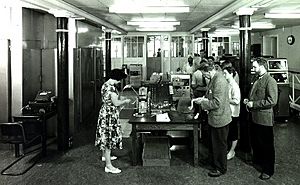EDSAC 2 facts for kids

EDSAC 2 users in 1960
|
|
| Developer | University of Cambridge, Mathematical Laboratory, UK |
|---|---|
| Release date | 1958 |
| CPU | 20-bit instructions with 11-bit addresses, two index registers, microcoded; @ fixed point add: 17-42 microseconds, floating point add: 100-170 microseconds |
| Memory | 1024 words RAM, 768 words ROM (core memory, 40-bit words) |
| Storage | block-structured magnetic tape, 16K words, core memory, added in 1962 |
| Input | 5-level paper tape, up to 1000 characters per second read, 300 cps punched output, two-out-of-five code |
| Predecessor | EDSAC |
EDSAC 2 was an important early computer built in the UK. It started working in 1958 and was the next version after the original Electronic Delay Storage Automatic Calculator (EDSAC). EDSAC 2 was special because it was one of the first computers to use a "microprogrammed control unit." This made it more flexible and easier to change how it worked. It also used a "bit-slice" design, which meant it was built from smaller, interchangeable parts.
Contents
What was EDSAC 2?
EDSAC 2 was a powerful machine for its time. It was developed at the University of Cambridge's Mathematical Laboratory. This computer was designed to be faster and more reliable than its predecessor, EDSAC.
How it Worked
EDSAC 2 used core memory for its main storage. This was a type of memory that used tiny magnetic rings to store information. It could hold 1024 "words" of information in its main memory (RAM) and 768 words in its permanent memory (ROM). A "word" was a group of 40 bits of data.
Speed and Input
The computer was quite fast for its era. It could do a simple addition in about 17 to 42 microseconds. A microsecond is one millionth of a second! For input, it used paper tape. This tape could be read at up to 1000 characters per second. It could also punch out results onto paper tape at 300 characters per second.
Important Discoveries Made with EDSAC 2
EDSAC 2 wasn't just a machine; it helped scientists and mathematicians make big breakthroughs.
Solving Math Problems
In the early 1960s, EDSAC 2 was used to do complex calculations about "elliptic curves." These calculations helped lead to the Birch and Swinnerton-Dyer conjecture. This is a very famous and difficult math problem that is still unsolved today. It's even one of the "Millennium Prize Problems," meaning there's a big prize for anyone who can solve it!
Understanding Earth's Plates
In 1963, two scientists, Frederick Vine and Drummond Matthews, used EDSAC 2 for another major discovery. They used data collected by a ship called H.M.S. Owen in the Indian Ocean. EDSAC 2 helped them create a map of magnetic patterns on the seafloor. This map provided key evidence that supported the theory of Plate Tectonics. This theory explains how the Earth's continents move over time.
EDSAC 2 was a pioneering computer that played a significant role in both mathematics and Earth sciences.


